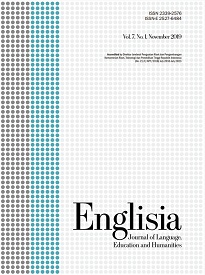The effect of movies on listening comprehension for Saudi EFL students
DOI:
https://doi.org/10.22373/ej.v11i2.20302Keywords:
Movie-based language learning, Listening skills, Student attitudes, Technology in language teaching, Language learners' beliefsAbstract
This study investigated the effectiveness of using movies to improve the listening skills of Saudi EFL students and their attitudes towards movie-based activities. A questionnaire was administered to 147 participants, 113 of whom were female and 34 of whom were male. The participants were divided into four age groups: 18-20 years, 21-25 years, 26-30 years, and above 30 years. Participants were required to have no history of hearing impairment or learning disabilities that may affect listening skills. Descriptive and inferential statistics were used to analyze the data. The results showed that movies had a positive impact on students' listening skills, and most participants had a positive attitude towards using movies as a learning tool. However, some challenges were also identified, such as finding appropriate movies and lacking guidance on effective movie use. The findings of this study have implications for English language teachers, providing insights into the benefits and challenges of using movies, and suggesting the need for training programs on incorporating movies into language teaching. Overall, this study contributes to understanding how technology-based tools like movies can enhance language learning outcomes.
Downloads
References
Al Murshidi, G. (2020). Effectiveness of movies in teaching and learning English as a foreign language at universities in UAE. Psychology and Education, 57(6), 442-450.
Alhamami, M. (2018). Directions to Digital Language Learning and Teaching. Createspace, Amazon.com. Link http://a.co/d/8fSKRyL
Alhamami, M. (2023). English as a Medium of Education (EME): Gender, Attitudes, and Cumulative GPA. King Saud University Journal of Research in Language and Translation, 3(2). 69-90.
Baharum, A., Naim, N. F. M., Ismail, R., Deris, F. D., & Noor, N. A. M. (2022, August). Movies and Learning: Does Watching Movies Help Students Improve Learn English?. In International Conference on Computational Science and Technology (pp. 205-217). Singapore: Springer Nature Singapore.
Bao, D., & Guan, C. (2019). Listening strategies. The TESOL Encyclopedia of English language teaching, 2, 1-6.
Birulés-Muntané, J., and Soto-Faraco, S. (2016). Watching subtitled films can help learning foreign languages. PLoS ONE 11, e0158409. doi: 10.1371/journal.pone.0158409
Bueno, K. A. (2009). Got film? Is it a readily accessible window to the target language and culture for your students?. Foreign Language Annals, 42(2), 318-339.
Çakır, İ. (2022). TV serials and movies to boost intercultural communicative competence in Turkish EFL context. International Journal of Applied Linguistics, 32(3), 397-410.
Chiu, Y. H. (2012). Can film dubbing projects facilitate EFL learners’ acquisition of English pronunciation? British Journal of Educational Technology, 43(1), 24–27. https://doi.org/10.1111/j.1467-8535.2011.01252.x
Crystal, D. (2021). "I Don’t Get It”: Researching the Cultural Lexicon of Global Englishes. In: Onysko, Alexander (ed.): Research Developments in World Englishes. London: Bloomsbury Academic, 173–198.
Dizon, G., & Thanyawatpokin, B. (2021). Language learning with Netflix: Exploring the effects of dual subtitles on vocabulary learning and listening comprehension. Computer Assisted Language Learning Electronic Journal, 22(3), 52-65.
Field, J. (2008). Listening in the language classroom. New York, NY: Cambridge University Press.
Fussalam, Y. E., Lestari, R., & Anggelia, R. Y. (2019). A study of listening skills through movie: a review of the current literature. Journal Of Language Education and Development (JLed), 1(2), 158-168.
Istanto, J. W. (2009). The use of films as an innovative way to enhance language learning and cultural understanding. Electronic Journal of Foreign Language Teaching, 6(1), 278-290.
Kipp, R. (2014). Using films to develop students' listening skills. The Language Teacher, 38(2), 37-40.
Koolstra, C. M., & Beentjes, J. W. (1999). Children’s vocabulary acquisition in a foreign language through watching subtitled television programs at home. Educational Technology Research and Development, 47(1), 51-60.
Kusuma-Powell, O., & Harbon, L. (2017). The role of film in language teaching. In C. Gitsaki (Ed.), Handbook of Research on Pedagogies and Cultural Considerations for Young English Language Learners (pp. 91-106). Hershey, PA: IGI Global.
Omar, F. R., & Razı, Ö. (2022). Impact of instruction based on movie and TV series clips on EFL learners’ pragmatic competence: Speech acts in focus. Frontiers in Psychology, 13, 974757.
Schmitt, N., & Schmitt, D. (2020). Vocabulary in language teaching. Cambridge university press.
Sturm, J. L. (2012). Using film in the L2 classroom: A graduate course in film pedagogy. Foreign Language Annals, 45(2), 246-259.
Downloads
Published
Issue
Section
License
Proposed Policy for Journals That Offer Open Access
Authors who publish with Englisia journal agree to the following terms:
- Authors retain copyright and grant the journal right of first publication with the work simultaneously licensed under a Creative Commons Attribution License that allows others to share the work with an acknowledgement of the work's authorship and initial publication in this journal.
- Authors are able to enter into separate, additional contractual arrangements for the non-exclusive distribution of the journal's published version of the work (e.g., post it to an institutional repository or publish it in a book), with an acknowledgement of its initial publication in this journal.
- Authors are permitted and encouraged to post their work online (e.g., in institutional repositories or on their website) prior to and during the submission process, as it can lead to productive exchanges, as well as earlier and greater citation of published work (See The Effect of Open Access).









